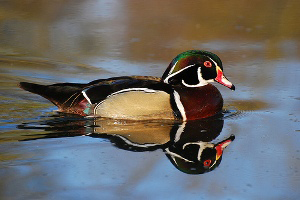Unlike most waterfowl, this beautiful duck is at home perching in trees, and it nests in cavities in trees or in nest boxes. In the late 1800s and early 1900s, wood duck populations declined dramatically due to over-hunting, wetland drainage, and deforestation. Wetland protection, regulation of hunting, and nest box programs have allowed a dramatic recovery of the species.
Photo Credit: Juan Rubiano
Aix sponsa
Common Name: wood duck
Animal Guild: Bird
Class > Order > Family: Aves > Anseriformes > Anatidae
What does the species look like?
The wood duck is a medium-sized duck with a prominent crest and relatively small bill. Male breeding plumage is strikingly colorful. The black and iridescent green of the head is highlighted by streaks of white along the crest, throat, and cheek, and further punctuated by the red eyes and base of the bill; the breast is burgundy, the flanks golden, and the back purplish black. Nonbreeding males, all females and juveniles have a distinctive white eye patch, a grayish back, and brown flanks. In flight, the wood duck’s broad wings, wedge-shaped tail, and irregular head bob are distinctive. The Mandarin duck is similar in appearance but not native to the U.S. and seen only as an escaped captive.
Where is the species found?
States & Provinces
AL, AR, AZ, BC, CA, CO, CT, DC, DE, FL, GA, IA, ID, IL, IN, KS, KY, LA, MA, MB, MD, ME, MI, MN, MO, MS, MT, NB, NC, ND, NE, NH, NJ, NL, NM, NS, NV, NY, OH, OK, ON, OR, PA, PE, QC, RI, SC, SD, SK, TN, TX, UT, VA, VT, WA, WI, WV, WY
Distribution
The breeding range extends across southern Canada. In the eastern United States, wood ducks breed from the central Great Plains to the Atlantic and Gulf coasts. In the western United States, they breed along the Pacific coast and in the northern intermountain area. This species winters in all but the northern-most part of this range, also in the desert Southwest, northern Mexico ,and Cuba.
The wood duck uses a wide range of habitat types including flowing and still water, and forested and herbaceous wetlands. Still water is favored as is vegetative cover, especially emergent plants and overhanging brush. Nesting requires trees generally over 12 inches in diameter to support an appropriate cavity. They will also nest in nest boxes.
General Phenology and Life History
Wood Ducks overwinter as far north as water remains open. Migratory populations begin returning to breeding ranges in February in Missouri, but not until April in Michigan’s upper peninsula. In northern areas, fall migration begins in mid-September and continues to mid-November and migration is later at lower latitudes. In Alabama, the beginning of fall migration averages 9 November, and wood ducks have left Missouri by mid-December. Nesting is initiated between January in the south and May in the north. Egg-laying takes 10-12 days, incubation lasts 25-35 days, and young leave the nest the morning after hatching. Juveniles can fly by 8-10 weeks. The wood duck is the only North American duck that regularly produces 2 broods in 1 breeding season; double brooding is more common at southern latitudes than in the north.
Which phenophases should I observe?
Do you see/hear...?
Activity
Live individuals More...
For abundance, enter the number of individual animals observed in this phenophase.
Feeding For abundance, enter the number of individual animals observed in this phenophase.
Calls or song For abundance, enter the number of individual animals observed in this phenophase.
Territorial individuals For abundance, enter the number of individual animals observed in this phenophase.
Reproduction
Courtship For abundance, enter the number of individual animals observed in this phenophase.
Mating For abundance, enter the number of individual animals observed in this phenophase.
Nest building For abundance, enter the number of individual animals observed in this phenophase.
Occupied nest For abundance, enter the number of individual animals observed in this phenophase.
Development
Downy young For abundance, enter the number of individual animals observed in this phenophase.
Partially-fledged young For abundance, enter the number of individual animals observed in this phenophase.
Fledged young For abundance, enter the number of individual animals observed in this phenophase.
Dead individuals For abundance, enter the number of individual animals observed in this phenophase.
Dead nestlings or fledglings For abundance, enter the number of individual animals observed in this phenophase.
Method
Individuals at a feeding station For abundance, enter the number of individual animals observed in this phenophase.
What do these phenophases look like?
There is currently no photoguide available for this species. If you'd like help us create one, use the guidance document and species template provided here . Then send it via email to education@usanpn.org when it is complete.
